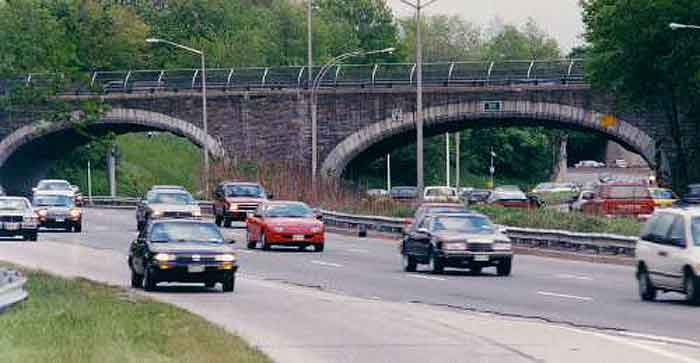Grand Central Parkway Union Turnpike looking East
 Grand Central Parkway, looking east toward the eastbound Union Turnpike overpass. This classic elliptical arch overpass was the dominant overpass arch style in the Flushing Meadows Park area and on the Long Island stretches of the parkway system. Most parkway overpasses within New York City tended to be vertical walled arches, as predominate on the Belt Parkway.
Grand Central Parkway, looking east toward the eastbound Union Turnpike overpass. This classic elliptical arch overpass was the dominant overpass arch style in the Flushing Meadows Park area and on the Long Island stretches of the parkway system. Most parkway overpasses within New York City tended to be vertical walled arches, as predominate on the Belt Parkway.Almost all parkway overpasses built for the city and state parkway system by Robert Moses were deliberately built too low for trucks and buses to go beneath. Part of the motivation was to ensure heavy commercial traffic didn't sully his idea of peaceful, bucolic ribbon parks, as he liked to envision is parkways to be. A more sinister sister motive was to keep out buses that might let the urban "riff raff" easily get to the state parks he created on Long Island and Westchester County. His reasoning was that few poor would venture to his precious parks and beaches if they had to endure long, monotonous train and bus trips via the older, traffic and signal clogged side roads.
By ordering so many overpasses low enough to prevent buses from using a speedy arterial express route, this misguided engineering genius instead condemned generations of commuters to automobile clogged nightmare commutes, not to mention what he forced upon area rapid transit by forcing buses onto the few highways and secondary roads feasible for them to use.
Eventually, many low overpasses were rebuilt to handle buses, but trucks, and even cars with commercial license plates, are still verboten on any arterial parkway. Nonetheless, it was not an uncommon occurrence for rush hour traffic to be brought to a standstill, due to a lost and oblivious 18 wheel tractor trailer truck trying to cram itself onto one of these parkways, and not a few of them ended up scrunched over one of the overpasses.
